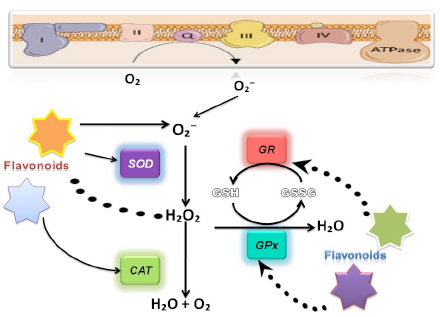Bioanálisis
Inhibición del estrés oxidativo inducido con peróxido de hidrógeno en Saccharomyces cerevissiae (evaluación de un extracto acuoso de Camellia sinensis)
Discussion and conclusions
Experimental data indicate that tea polyphenols may offer indirect protection by activating endogenous defense systems (11). The observed effect is due to that the phenolics compounds, EC, ECG, EGC and EGCG, present in the extract organic green tea artisanal, can indirectly regulate the expression and activity of enzymes such as CAT, SOD and glutathione (12) (Fig. 2). Although it is not known with certainty what mechanisms S. cerevisiae carries out to promote its growth in an oxidative stress environment, it was evidenced that the compounds present in the extract are capable of stimulating the cells to follow their normal growth path, which is perhaps related to the ability of the extracts to activate or deactivate physiological mechanisms associated with the protection of the yeast or with simple reduction H2O2 (13, 14). 
Figure 3. Effect on the enzyme system of phenolic compounds presentyes in C. sinenesis. Previous studies have reported that different phenolic compounds (quercetin, resveratrol, and hesperidin), are able to protect yeast cells against damage caused by different stressing agents (14,15). The antioxidant effect of tea ingestion requires more evidence to unravel the mechanism of action and the ingredients involved. Despite there being no convincing evidence from long-term intervention studies in humans, tea flavanols are still considered to be the major candidates involved in the biological activity of teas. Possible mechanisms of action, such as the induction of an endogenous redox pathway or direct effects of polyphenol metabolites, should be elucidated so that the molecules responsible for the effect can isolated and clear-cut evidence can be obtained from long-term intervention studies(17). Natural antioxidants are an interesting alternative in view of their variety of structures and chemical interactions, as well as the numerous biological activities they can perform. Intensive research activities are currently being carried out on plant antioxidants to meet this challenge (18). The in vitro and in vivo antioxidant activities of some natural products could be consistent in certain conditions. Overall, in vitro antioxidant activity and phenolic profiles of tea can provide
Conclusions The extract of green tea showed a protective effect in the presence of an excess of H2O2 molecules, which favours or contributes to the metabolism of S. cerevisiae. The results in this research evidence that the consumption of green tea has beneficial effects on health and prevention of chronic pathologies, such as cardiovascular disease and cancer, in which oxidative stress plays a critical role.
|